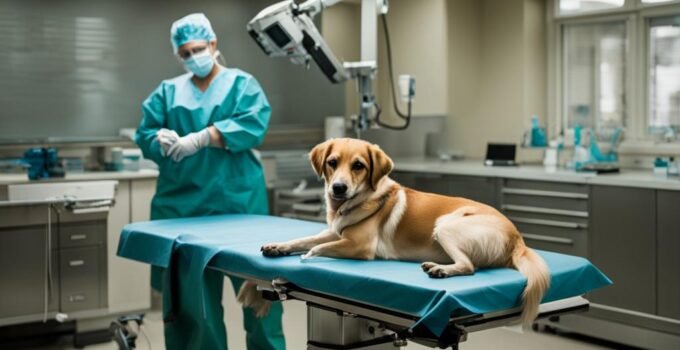If you have a pet and they require TPLO surgery, you may be wondering if your pet insurance will cover the cost of this procedure. In this article, I will delve into the coverage options for TPLO surgery and provide you with information on the best pet insurance providers that offer coverage for this particular surgery.
TPLO surgery, short for tibial plateau leveling osteotomy, is a common surgical procedure performed on dogs with cranial cruciate ligament (CCL) injuries. It involves cutting and reshaping the tibia to create a more stable knee joint. This surgery is essential for maintaining knee stability in dogs that have suffered a torn CCL, similar to the ACL in humans.
Key Takeaways:
- Pet owners often wonder if their pet insurance will cover the cost of TPLO surgery.
- TPLO surgery is performed on dogs with torn cranial cruciate ligaments (CCL).
- Pet insurance coverage for ACL surgery works similarly to coverage for other veterinary expenses.
- Several pet insurance providers offer coverage for ACL surgery, including Lemonade, Spot, Trupanion, Fetch, Embrace, Healthy Paws, and Prudent Pet.
- The cost of TPLO surgery can vary depending on factors such as location, weight of the pet, and additional complications.
Understanding TPLO Surgery for Dogs
TPLO surgery is a common procedure performed to stabilize the knee joint in dogs that have suffered a torn cranial cruciate ligament (CCL). This ligament is similar to the ACL in humans and is crucial for maintaining knee stability.
During TPLO surgery, the tibia is cut and reshaped to create a more stable joint, eliminating the need for the damaged CCL. This surgical technique allows the dog to regain mobility and reduce pain associated with the CCL injury.
While TPLO surgery is one option for ACL injuries in dogs, other surgical approaches include lateral suture/extracapsular repair and tibial tuberosity advancement (TTA). However, TPLO surgery is often preferred because it provides better long-term stability and reduces the risk of subsequent arthritis.
How Does Pet Insurance Coverage for ACL Surgery Work?
Pet insurance coverage for ACL surgery is similar to coverage for other veterinary expenses. Once the initial diagnosis has been made and treatment options have been discussed, pet owners are responsible for scheduling and paying for the procedure out of pocket. However, they can then file a claim with their insurance company to seek reimbursement for eligible expenses related to ACL surgery.
The coverage provided by pet insurance for ACL surgery typically includes X-rays, the cost of the surgery itself, medications, and other medical expenses associated with the procedure. This can help alleviate the financial burden of the surgery and ensure that pets receive the necessary care without owners having to worry about the cost.
It’s important to note that preexisting conditions are usually excluded from coverage. This means that if your pet had a preexisting ACL injury or any related conditions before obtaining pet insurance coverage, those expenses may not be reimbursed.
Obtaining pet insurance coverage for ACL surgery is a proactive step that can give pet owners peace of mind and financial protection. By understanding how the reimbursement process works and reviewing the coverage options provided by different insurance companies, pet owners can make informed decisions to ensure their pets receive the best care possible.
Pet Insurance Companies That Cover ACL Surgery
When it comes to ACL surgery for your pet, having the right insurance coverage can provide peace of mind and financial support. Several reputable pet insurance companies offer policies that cover ACL surgery, ensuring that you can provide the best care for your furry friend without breaking the bank.
Here are some of the top pet insurance providers that offer coverage for ACL surgery:
- Lemonade pet insurance: Lemonade offers comprehensive coverage for ACL surgery, including pre-surgical consultations, diagnostics, surgery, anesthesia, and post-operative care. They also provide coverage for any complications that may arise during the recovery period.
- Spot pet insurance: Spot understands the importance of ACL surgery and provides coverage for the procedure. Their policies cover the cost of surgery, as well as pre-surgical consultations, examinations, X-rays, and post-operative care.
- Trupanion pet insurance: Trupanion offers coverage for ACL surgery and provides reimbursement for eligible expenses. Their policies also cover pre-surgical diagnostics, examinations, overnight hospital stays, and follow-up care.
- Fetch pet insurance: Fetch understands the financial burden of ACL surgery and offers coverage for the procedure. Their policies include pre-surgical consultations, diagnostics, surgery, anesthesia, and post-operative care.
- Embrace pet insurance: Embrace provides coverage for ACL surgery, ensuring that your pet receives the best care possible. Their policies cover the cost of surgery, as well as pre-surgical consultations, diagnostics, anesthesia, and post-operative care.
- Healthy Paws pet insurance: Healthy Paws offers coverage for ACL surgery to help pet owners manage the expenses associated with the procedure. Their policies cover the cost of surgery, as well as pre-surgical exams, diagnostics, anesthesia, and post-operative care.
- Prudent Pet insurance: Prudent Pet understands the importance of ACL surgery and provides coverage for the procedure. Their policies cover the cost of surgery, as well as pre-surgical consultations, diagnostics, anesthesia, and post-operative care.
It’s important to note that each insurance company has specific coverage details, waiting periods, and exclusions. Before choosing a pet insurance provider, it’s crucial to review their policies thoroughly to ensure that they meet your needs and provide the necessary coverage for ACL surgery.
Having the right pet insurance coverage can give you peace of mind and allow you to focus on your pet’s health and recovery rather than worrying about the financial aspect. Consider these reputable pet insurance companies when seeking coverage for ACL surgery.
Cost of Pet Insurance for ACL Surgery Coverage
The cost of pet insurance for ACL surgery coverage can vary depending on the provider and the specifics of the policy. Several reputable pet insurance companies offer coverage for ACL surgery, including Lemonade, Spot, Trupanion, Fetch, Embrace, Healthy Paws, and Prudent Pet. Each company has different pricing options, so it’s essential to compare their policies to find the best fit for your needs and budget.
When determining the cost of pet insurance, factors such as the pet’s age, breed, and location play a significant role. The average cost of pet insurance can range from $20 to $100 per month. However, specific pricing details can be obtained by requesting a quote directly from the insurance providers. Keep in mind that the cost of insurance premiums can vary based on various factors, and it’s essential to review the policy details and coverage limits carefully.
Insurance coverage for ACL surgery can provide financial peace of mind and help offset the expenses associated with the procedure. By selecting a pet insurance plan that includes coverage for ACL surgery, you can ensure that your furry friend receives the necessary medical care without placing a significant financial burden on your wallet.
Is ACL Surgery Common for Dogs?
ACL surgery, also known as anterior cruciate ligament surgery, is a relatively common procedure for dogs. While it is more prevalent in certain breeds, it can affect dogs of all sizes and ages. Labrador retrievers, Newfoundlands, German shepherds, Rottweilers, and Golden retrievers are among the breeds that are more prone to ACL injuries. However, it is important to note that only a small percentage of dogs will experience a torn ACL in their lifetime.
Dog Breeds Prone to ACL Injuries
| Breed | Prone to ACL Injuries? |
|---|---|
| Labrador Retriever | Yes |
| Newfoundland | Yes |
| German Shepherd | Yes |
| Rottweiler | Yes |
| Golden Retriever | Yes |
While these breeds are more prone to ACL injuries, it is important to remember that any dog can be affected. It is crucial to provide proper care, exercise, and monitoring for all dogs to reduce the risk of ACL injuries and promote overall joint health.
Is ACL Surgery Common for Cats?
While ACL injuries are less common in cats compared to dogs, they can still occur. Cats with partial tears or ruptures in their ACL may be able to manage their condition through non-surgical methods, such as medication, joint supplements, and restriction of exercise. However, if the cat’s condition does not improve or worsens, surgical intervention may be necessary to restore proper joint function and alleviate pain.
It’s important for cat owners to closely monitor their pets for any signs of ACL injury, such as limping, difficulty jumping, or decreased activity levels. If any of these symptoms are noticed, it’s essential to consult with a veterinarian for a comprehensive examination and accurate diagnosis.
What Is TPLO Surgery for Dogs?
TPLO surgery, or tibial plateau leveling osteotomy, is a surgical procedure performed to stabilize the knee joint in dogs that have experienced a rupture of the cranial cruciate ligament (CCL). The CCL is an important ligament in the knee that helps maintain stability. When the CCL ruptures, the knee becomes unstable, causing pain and limited mobility for the dog.
The goal of TPLO surgery is to create a more stable joint by cutting and rotating the top portion of the tibia. This restructuring eliminates the need for the CCL and allows the joint to regain stability. By stabilizing the knee, TPLO surgery helps relieve pain and restore normal movement and function for the dog.
Tips to Help Your Dog Recover From TPLO Surgery
The recovery process after TPLO surgery is crucial for your dog’s successful rehabilitation. Following your veterinarian’s instructions is essential. Here are some tips to help your dog recover:
- Obey the recovery instructions provided by your veterinarian.
- Prepare your home to ensure a safe and comfortable recovery environment.
- Encourage stillness and limit your dog’s activity level to prevent further injury.
- Protect the incision site by keeping it clean and dry.
- Use ice packs, as recommended by your veterinarian, to reduce swelling and discomfort.
- Give your dog pain medications as prescribed to manage post-surgery pain.
- Provide mental stimulation through interactive toys and games to keep your dog engaged during the recovery period.
By following these tips, you can support your dog’s healing process and promote a successful TPLO recovery.
| Recovery Tips | Benefits |
|---|---|
| Obey the recovery instructions provided by your veterinarian. | Ensures proper healing and minimizes the risk of complications. |
| Prepare your home to ensure a safe and comfortable recovery environment. | Reduces the chances of accidents or further injuries during recovery. |
| Encourage stillness and limit your dog’s activity level to prevent further injury. | Aids in the healing process and prevents strain on the surgical site. |
| Protect the incision site by keeping it clean and dry. | Reduces the risk of infection and promotes proper wound healing. |
| Use ice packs, as recommended by your veterinarian, to reduce swelling and discomfort. | Helps alleviate pain and inflammation, aiding in the recovery process. |
| Give your dog pain medications as prescribed to manage post-surgery pain. | Provides relief from pain, ensuring your dog can rest comfortably. |
| Provide mental stimulation through interactive toys and games to keep your dog engaged during the recovery period. | Prevents boredom and promotes a positive mindset throughout the healing process. |
How Much Does TPLO Surgery Cost?
The cost of TPLO surgery can vary depending on several factors. The location of the veterinary clinic, the pet’s weight, the specific veterinarian performing the surgery, and any additional complications that may arise can all affect the overall cost of the procedure. It’s important to consider these factors and obtain a detailed estimate from your veterinarian before proceeding with the surgery.
On average, TPLO surgery can cost between $3,000 and $6,000 or more. However, this is just a general range, and the actual cost can differ significantly based on the unique circumstances of each case. The pet’s weight is a crucial consideration since larger dogs generally require more time, resources, and expertise during the procedure.
Location is another significant factor affecting the cost. The cost of living and veterinary services can vary significantly depending on the region and city in which the clinic is located. Urban areas and regions with a high cost of living are likely to have higher surgical costs compared to rural areas or regions with a lower cost of living.
Choosing a veterinarian with experience and expertise in TPLO surgery is also a critical factor. Experienced veterinarians who specialize in orthopedic surgery may have higher costs due to their advanced skills and reputation.
To get an accurate estimate for TPLO surgery cost, it is recommended to schedule a consultation with a veterinarian who is familiar with the procedure. They will conduct a comprehensive evaluation of your pet’s condition, consider any unique factors, and provide an estimate tailored to your specific situation.
It’s crucial to remember that the cost of TPLO surgery is an investment in your pet’s health and quality of life. While the expense may seem significant, it’s important to prioritize your pet’s well-being and consider the long-term benefits of the procedure.
What’s Included in the Cost of TPLO Surgery for Dogs?
When considering TPLO surgery for your dog, it’s important to understand the breakdown of the cost. The total cost of TPLO surgery includes several components that contribute to the overall expense. Here is a breakdown of what is typically included in the cost:
X-rays
Prior to the surgery, X-rays are necessary to assess the condition of the affected knee joint. X-rays help the veterinarian determine the extent of the injury and plan the surgical procedure accordingly.
Pre-Surgical Bloodwork
Pre-surgical bloodwork is performed to evaluate your dog’s overall health and identify any underlying conditions or potential risks. It ensures that your pet is a suitable candidate for surgery and helps the veterinarian make informed decisions during the procedure.
Surgical Equipment
The cost of TPLO surgery includes the use of specialized surgical equipment and instruments. These tools are crucial for performing the procedure safely and effectively.
Surgery Room Expenses
The use of a sterile, well-equipped surgery room is necessary to minimize the risk of infection and ensure a sterile environment for the surgery. The cost of TPLO surgery covers the expenses associated with maintaining and utilizing the surgery room.
The Procedure Itself
The cost of TPLO surgery includes the actual surgical procedure, during which the veterinarian makes the necessary incisions, cuts, and reshapes the tibia to stabilize the knee joint. This is the core component of TPLO surgery.
Post-Operative Monitoring
After the surgery, your dog will require monitoring to ensure a smooth recovery. The cost of TPLO surgery typically includes post-operative monitoring to assess your pet’s progress and address any potential complications or concerns.
Pain Medications
Pain management is an essential aspect of TPLO surgery recovery. To keep your dog comfortable and alleviate discomfort, pain medications are provided as part of the surgical cost.
Outpatient Exams
Regular follow-up visits are essential to monitor your dog’s healing process and address any post-surgical concerns. The cost of TPLO surgery often includes outpatient exams to evaluate your pet’s progress and make any necessary adjustments to their recovery plan.
Suture Removal
Once your dog has recovered sufficiently, the sutures used during the surgery will need to be removed. The cost of TPLO surgery typically covers the expenses associated with suture removal.
It’s important to note that these are general components often included in the cost of TPLO surgery. However, it’s recommended to clarify with your veterinarian what specific inclusions and exclusions apply to the surgical cost for your dog.
Conclusion
In conclusion, TPLO surgery is a common procedure for dogs with cranial cruciate ligament (CCL) injuries. This surgery is vital for stabilizing the knee joint and restoring mobility in affected dogs. The cost of TPLO surgery can be significant, but pet insurance can help alleviate the financial burden.
By understanding the coverage options provided by different pet insurance providers, pet owners can ensure that their pets receive the necessary care without facing financial stress. It’s crucial to review policy details, waiting periods, and exclusions when selecting a pet insurance plan to ensure that TPLO surgery is included in the coverage.
With the right pet insurance coverage, pet owners can have peace of mind knowing that they will be able to provide their furry companions with the best possible care, including TPLO surgery, when needed. TPLO surgery is a major undertaking, and having insurance coverage can make a significant difference in accessing the necessary treatment and ensuring a smooth recovery for dogs with CCL injuries.



